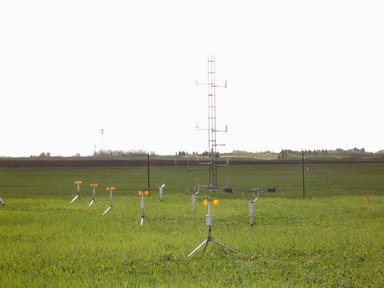
Oblique, Stratified Winds about a Shelter Fence
- Wilson, J.D., 2004, Oblique, Stratified Winds about a Shelter Fence, I: Measurements J. Applied Meteorol., 43, 1149-1167.
- Wilson, J.D., 2004, Oblique, Stratified Winds about a Shelter Fence, II: Comparison of Measurements with Numerical Models. J. Applied Meteorol., 43, 1392-1409.
- Preliminary description of the experiment (pre-dating the publications).
A windbreak generates one of the canonical disturbances of the atmospheric surface layer, and as such, is of interest both theoretically and practically. From the theoretical side, it provides a well-defined test flow to assess the objectivity and reliability of the existing numerical wind models - which are akin to weather models, but are (even more) notoriously dependent on empirical parameterization of unknown terms in the governing equations (the "closure problem" of turbulent fluid mechanics). Thus as noted in the Introduction to Part II, the performance of shelter simulations is a diagnostic for "the viability and objectivity of computational fluid mechanics, which has assumed a pivotal role in society regarding environmental planning and regulation" (eg. air pollution models).
The experiment, performed at Ellerslie (Alberta), entailed 11 cup anemometers, 8 two-dimensional and 2 three-dimensional sonic anemometers. The wind statistics depend on many controlling parameters: height above ground, distance from the windbreak, mean angle of approach of the wind ("obliquity"), and the thermal stratification of the atmosphere ("stability"). New effects were discovered, and a new concept ("potential shelter") introduced: specifically, it was found that (contrary to expectation) both unstable (daytime) and stable( night time) thermal stratification render a windbreak less effective, and that best shelter ("potential shelter") occurs in the "neutral" case (strong, perpendicular winds; and cloudy skies).
However the specific information gained about windbreak flow is a less important facet of this experiment than the basis it provided to answer the following question, posed in the second paragraph of Part I: "May we say disturbed winds about a shelter fence are objectively computable, with today's (wind) models?" Based on comparisons of numerical simulations (using standard turbulence closures) with the experimental data, the Part II concludes that
- simulations play a useful guiding role in the analysis of observations
- computed responses of the mean wind transect to varying angle of approach and atmospheric stability are qualitatively correct but quantitatively poor; while computed turbulence statistics are unacceptable (note: If computed winds are to be useful for the calculation of, eg., pollen transport, not only the mean (average) wind but also turbulence statistics, especially velocity standard deviations, must be computed adequately): "May one draw the conclusion, of some significance for the application of (wind) models in environmental analysis and assessment, that these models do not objectively capture reality..?"
- one should "avoid the premature employment (of wind models) as a substitute for measurements"
Related Work
- Wilson, J.D. and T.K. Flesch, 2003, Wind measurements in a square plot enclosed by a shelter fence. Boundary-Layer Meteorology, 109, 191-224.
- Wilson, J.D., and E. Yee, 2003, Calculation of Winds Disturbed by an Array of Fences. Agric. For. Meteorol., 115, 31-50.
Back to Disturbed Windflows
Last Modified: 7 Sept., 2005
